The upright row is a compound weightlifting exercise that involves multiple joints and simultaneously engages several muscle groups. It primarily targets the deltoids (shoulders) and trapezius, while also working the biceps, forearms, and upper back.
When you do an upright row, you’re basically pulling a weight up along the front of your body to about chest height. It might seem simple, but there’s actually a lot going on here that makes it unique.
One thing I really like about the upright row is how it challenges your body’s vertical pulling strength.
Most pulling exercises we do are either horizontal (like rows) or overhead (like pull-ups). The upright row fills this middle ground, helping to round out your pulling strength in all directions.
There are many variations of the upright row you can do with barbells, dumbbells, cables, and other gym equipment. You can also use different grips. I like cable upright row.

- Upright Row Muscles Worked
- How to Do the Upright Row
- Upright Rows Form And Tips
- 1. Make Sure Your Hands Aren’t Too Close Together
- 2. Avoid Lifting Too Much Weight
- 3. Don’t Pull the Bar too High
- 4. Brace Your Core and Keep Your Torso Upright
- 5. Don’t Roll Shoulder Forward
- 6. Try Different Upright Row Grip Position
- Variations of Shoulder Upright Row
- 1. Wide Grip Barbell Upright Row
- 2. Dumbbell Upright Row
- 3. Cable Upright Row
- 4. One-Arm Dumbbell Upright Row
- 5. Smith Machine Upright Row
- 6. Kettlebell Upright Row
- 7. Resistance Band Upright Row
- FAQs
- Is the Upright Row Bad for You?
- Are upright rows bad for your elbow?
- Is upright row push or pull
- Which muscles do upright rows work?
- Can the upright row cause shoulder impingement?
- Are upright rows good for posture?
- Are upright rows better with dumbbells or barbells?
- How much weight should I use for an upright row?
- Are upright rows better than lateral raises?
- Reference
Upright Row Muscles Worked
It is a real upper body powerhouse that targets some of the body’s most integral muscle groups, including:
- The primary muscles work: the lateral deltoid and upper trap.
- Secondary Muscles Worked: anterior Deltoid, Rear Deltoid, Supraspinatus, Brachialis, Brachioradialis, Biceps Brachii, Middle and Lower Trapezius, Rhomboids, Serratus Anterior, and Teres Minor.
- A handful of other muscles or stabilizers muscles worked: wrist flexors, Obliques, and Rectus abdominis.

How to Do the Upright Row
- Stand with your feet shoulder-width apart to maintain a stable base. Hold a barbell with an overhand grip (palms facing you).
- Your hands should be slightly narrower than shoulder-width apart. Alternatively, you can use dumbbells or a cable machine for this exercise.
- Keep your back straight, shoulders relaxed, and chest lifted.
- The barbell should hang directly in front of you, with your arms extended and hands close together.
- Pull the barbell toward the chest, keeping your elbow above your wrist. Keep the bar close to you as you move.
- The bar should be just below your chin or until your elbows reach shoulder height.
- It’s essential not to force the range of motion; go as high as comfortably possible.
- Slowly lower the barbell back down to the starting position in a controlled manner. This eccentric part of the movement is just as crucial as the lifting phase.
- Exhale as you lower the weight.
Upright Rows Form And Tips
We will teach you how to do an upright row correctly with form and techniques that best avoid shoulder pain and injury.
1. Make Sure Your Hands Aren’t Too Close Together
Make sure your hands aren’t too close together. When your hands are too close together, it can increase the amount of ulnar deviation (how much your wrist must bend to the side).
This can lead to wrist injury, which you can easily avoid by widening your grip so that it is more comfortable as you lift.
2. Avoid Lifting Too Much Weight
One of the most common mistakes people make when performing the upright row is using too much weight. This approach may place undue strain on your shoulders and increase your risk of injury.
To avoid this, start with a lighter weight and focus on maintaining proper form and technique.
Choose a barbell or weight that’ll allow a nice, slow and controlled movement.
3. Don’t Pull the Bar too High
Pulling the bar too high can increase compression of the acromioclavicular joint, increasing the likelihood of an impingement injury at the shoulder.
Controlling the movement and limiting your elbows to reach the same height as your shoulders ensure you are not exerting your shoulder and potentially causing an injury
4. Brace Your Core and Keep Your Torso Upright
As with any lift, maintaining a strong and stable core throughout the lift will aid with bracing and thus protect the spine.
This will also help reduce or prevent swinging the weight away from your center of mass when performing upright rows.
5. Don’t Roll Shoulder Forward
When lowering the weight, make sure your chest is proud and shoulders pulled back/together (known as scapular retraction).
Retracting the scapulae puts the shoulders in a strong position to lift and will help focus the exercise on the deltoid.
6. Try Different Upright Row Grip Position
When performed correctly, the barbell upright row can be a fantastic muscle-building exercise for the upper back and shoulders, helping to shape the upper arms and torso.
The grip width is one key factor influencing muscle activation and emphasis in this exercise.
There are three main variations of grip width: close grip, normal grip, and wide grip. All have their unique advantages and disadvantages. Let’s take a closer look at each of these variations:
- A close or narrow grip (half of the shoulder width): It emphasizes the upper trap more and the lateral delt and rear delt less.
- A standard grip (shoulder-width grip): It provides overall shoulder development and is suitable for those seeking balanced muscle activation.
- A wide grip (wider than the shoulder): The wide-grip upright row places heavy emphasis more in the lateral and rear deltoid and little lessor on the upper and middle trap. Furthermore, the wider grip allows some cheating movement, thereby allowing you to lift more weight.
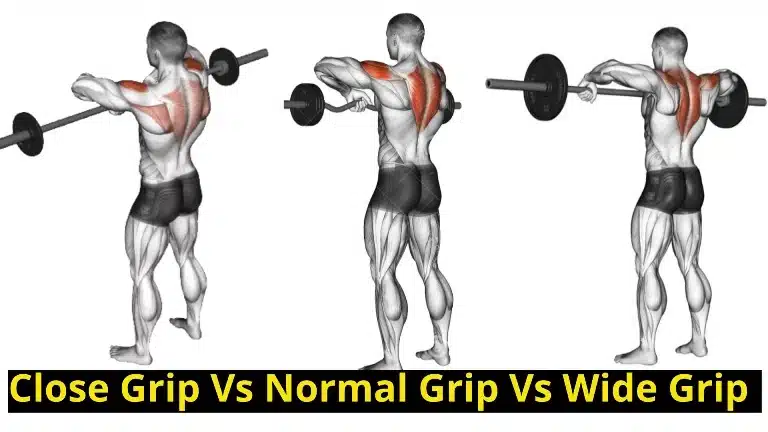
Variations of Shoulder Upright Row
You can also perform the upright row with a cable machine or resistance bands, which provide different types of resistance.
Beginners should start with a cable machine, dumbbells, EZ bar, or bands.
1. Wide Grip Barbell Upright Row
Barbell upright row is an excellent exercise to build huge Trapezius muscles and create that deltopectoral separation.
The wide grip upright row is a variation of the traditional upright row exercise where the barbell and bar are grabbed with wider than shoulder-width apart.
The wider grip can help reduce the risk of shoulder impingement by minimizing internal shoulder rotation, which is common with narrower grips.
One thing to keep in mind: because you’re using a wider grip, you might not be able to lift as much weight as you would with a narrow grip. But don’t let that discourage you. The increased isolation of the lateral delts means you’re getting quality work with potentially less strain on your joints.
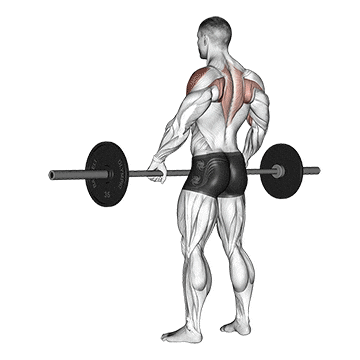
2. Dumbbell Upright Row
The dumbbell upright row is a compound exercise that builds stronger and bigger traps, and rear deltoids (Shoulder).
Dumbbells give you a level of freedom that you just don’t get with a barbell. When you’re holding a dumbbell in each hand, your arms can move independently.
These exercises variations allow for a greater range of movement (ROM). Dumbbells require more balance than barbells or machines, which can lead to greater muscle fiber recruitment.
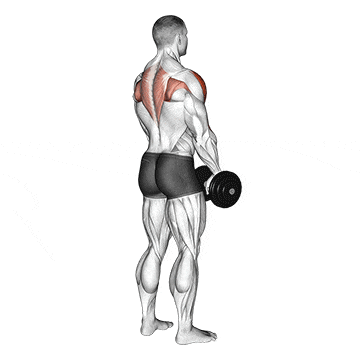
3. Cable Upright Row
The cable upright row is a variation of the upright row and an exercise used to build the muscles of the shoulders and traps.
When you’re using a barbell or dumbbells, there’s a point at the bottom of the movement where the weight is just hanging. Not so with cables. Your muscles are under tension from the moment you start the lift to when you lower it back down. This means more time under tension for your muscles.
Cable machines keep tension on the muscles throughout the entire range of motion, ultimately increasing muscle activation and hypertrophy.
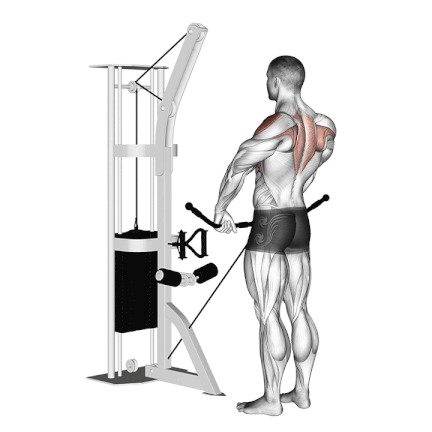
4. One-Arm Dumbbell Upright Row
We all have some degree of muscle imbalance between our left and right sides. With a barbell, your stronger side might compensate for the weaker one without you even realizing it.
But with dumbbells in a single arm, it has to do its fair share of the work. This can help you identify and correct any strength imbalances over time.
It allows good range of motion, as you’re not locked into a fixed path like you are with a barbell. This allows for a more natural movement pattern.
As you lift the dumbbells, you can let your elbows flare out slightly if that feels more comfortable. This can be especially helpful if you have any shoulder mobility issues.
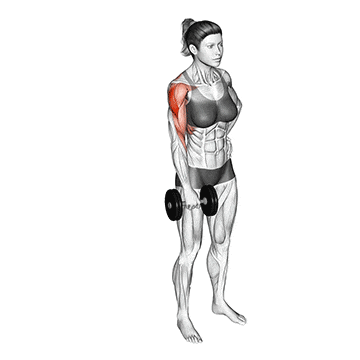
5. Smith Machine Upright Row
The Smith machine upright row is a variation of the upright row that can help get you bigger deltoids and trapezius muscles.
Compared to using dumbbells or a barbell, the smith machine offers an advantage for performing upright rows with better balance and control.
The Smith Machine’s guided bar path helps ensure proper form and technique throughout each exercise repetition.
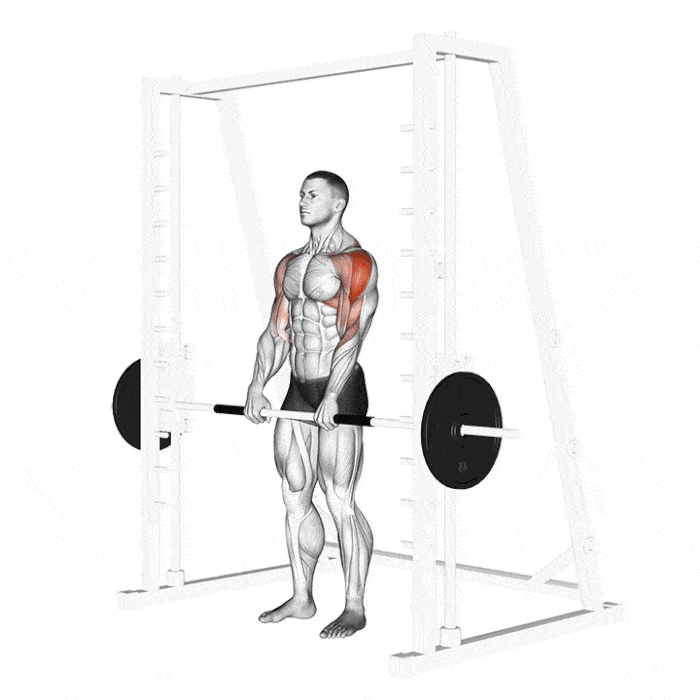
6. Kettlebell Upright Row
Unlike a dumbbell or barbell, the kettlebell’s center of mass hangs below your hands. This creates a longer lever arm, which means your muscles have to work harder throughout the movement. It’s like nature’s way of adding extra challenge to your lift
The Kettlebell upright row allows more movement in your wrists and arms and is less likely to force any internal shoulder rotation.
You can use one kettlebell with both hands or do a double kettlebell upright row. Each version challenges your muscles in slightly different ways.
Again, opt for a kettlebell in a bit less than half the weight of a barbell you were working with.
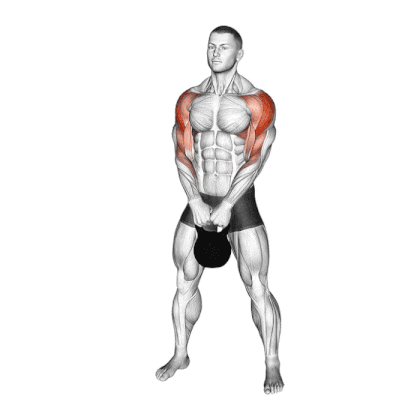
7. Resistance Band Upright Row
The resistance band upright row is a variation of the upright row and an exercise used to build the shoulders and traps muscles.
Utilizing the resistance band is useful in that it provides constant tension on the target muscle group as you move the weight through the range of motion.
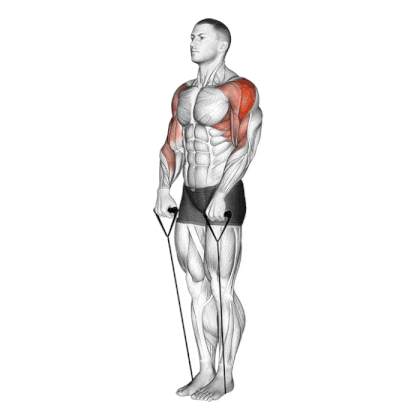
FAQs
Is the Upright Row Bad for You?
The upright row exercise is either good or bad, it mainly depends on how it’s performed.
In the traditional upright row, you do it with a barbell with your narrow grip or relatively close together. When your elbows are positioned higher than your shoulders, this may cause the shoulder joint to undergo internal rotation. This becomes a risk, particularly when using heavy weights.
In this position, the head of the humerus (the upper arm bone) can encroach upon the space between other bones in the shoulder. This can cause the bones in your shoulder to rub against rotator cuff tendons and other soft tissues, potentially leading to shoulder impingement or injury over time.
However, this doesn’t mean you should avoid the upright row altogether. Improve your technique and form to minimize these risks and perform the exercise safely.
For example, using a wider grip, reducing the weight, or opting for variations like the cable upright row can help reduce the risk of shoulder issues.

Are upright rows bad for your elbow?
No, the upright row is not harmful to your shoulders, wrists, and elbows. It is important to make sure you are performing the upright row with proper technique, modifying the exercise based on your individual needs, and considering your training program as a whole.
Is upright row push or pull
The upright row is primarily considered a pull exercise as it involves pulling the weight vertically toward the body.
A push exercise involves pushing a weight away from the body, such as a bench press or push-up, while a pull exercise involves pulling a weight towards the body, such as a row or pull-up.
Which muscles do upright rows work?
The upright row is a compound exercise that primarily works the upper back muscles, including the trapezius, rhomboids, and latissimus dorsi. It also works the muscles of the forearms and biceps to a lesser extent.
Can the upright row cause shoulder impingement?
Shoulder impingement can occur when performing the upright row with improper form or too much weight.
To avoid this, keep your elbows close to your body and your wrists straight throughout the movement.
Are upright rows good for posture?
Upright rows can be a good exercise for improving posture, as they work the upper back muscles, including the trapezius, rhomboids, and latissimus dorsi.
These muscles move, rotate, and stabilize the shoulder blades, and strengthening them can help improve posture.
However, it is important to maintain proper form when performing upright rows to ensure they are effective and safe.
In addition to upright rows, other exercises, such as planks, bird dogs, and seated rows, can help improve posture.
Are upright rows better with dumbbells or barbells?
Both dumbbells and barbells can be used to do upright rows.
The best choice for you may depend on your personal preference and the equipment you have available.
Here are some things to think about:
Dumbbell Upright Row:
- Greater range of motion
- Allows independent arm movement
- Requires greater core stabilization
- They may also be easier to grip.
- Offers various grip options for different muscle emphasis
Barbell Upright Row:
- Allow you to lift heavier weights
- Promotes symmetrical movement
- It may provide better wrist alignment
- increase your strength and build muscle mass.
- Suitable for overall upper body development and coordination
I would suggest using dumbbells instead of a barbell if you have any pre-existing injuries or conditions. Dumbbells will allow for a more natural movement pattern and put less strain on your shoulders, as they will affect your shoulders.
Ultimately, the best choice for you will depend on your specific goals and needs. It may be helpful to try both and see which feels more comfortable and effective.
How much weight should I use for an upright row?
It depends on your goals and your strengths. Doing this exercise with a lot of weight and few repetitions is risky for your joints.
Pick a weight that allows you to do 10 to 20 reps and 3-4 sets.
If you don’t put in enough weight, you won’t get the benefits of exercise, but if you put too much weight, you’ll end up in bad form and possibly getting hurt.
Start with a weight that you can lift around 15 times with good intensity.
Are upright rows better than lateral raises?
It’s not really accurate to say that one exercise is “better” than the other, as both the upright row and lateral raise.
- The upright row is a compound exercise that targets the upper back and shoulder muscles, including the trapezius, rhomboids, and deltoids. It is a good exercise for building strength and mass in these muscles.
- The lateral raise is an isolation exercise that targets the lateral head of the deltoid muscle. It is good for shaping and strengthening the shoulders and can also help improve shoulder stability and mobility.
To reap the benefits of both exercises, you can try incorporating upright rows and lateral raises into your routine.
Thanks for reading.
Reference
- Schoenfeld, Brad MSc, CSCS; Kolber, Morey J PT, PhD, CSCS; Haimes, Jonathan E BS, CSCS: The Upright Row: Implications for Preventing Subacromial Impingement. Strength and Conditioning Journal: October 2011 – Volume 33 – Issue 5 – p 25-28
- Ronai, Peter MS, CSCS, RCEP: Exercise Modifications and Strategies to Enhance Shoulder Function. Strength and Conditioning Journal: August 2005 – Volume 27 – Issue 4 – p 36-45
- McAllister M, Schilling B, Hammond K, Weiss L, Farney T. Effect of grip width on electromyographic activity during the upright row. J Strength Cond PMID: 22362088 DOI: 10.1519/JSC.0b013e31824f23ad
- Cools AM, Witvrouw EE, Declercq GA, Danneels LA, Cambier DC. Scapular muscle recruitment patterns: Trapezius muscle latency with and without impingement symptoms. Am J Sports Med 31: 542–549, 2003.
- Int J Environ Res Public Health. Trapezius muscle timing during selected shoulder rehabilitation exercises. 2021 Jun 14;18(12):6444. doi: 10.3390/ijerph18126444.PMID: 34198674
- Lorenzetti S, Dayer R, Pluss M, List R. Pulling exercises for strength training and rehabilitation: movements and loading conditions. J Funct Morphol Kinesiol. 2017;2(3):33. doi:10.3390/jfmk2030033
- Mazur LJ, Yetman RJ, Risser WL. Weight-training injuries. Common injuries and preventative methods. Sports Med 16: 57–63, 1993.

Manish is a NASM-certified fitness and nutrition coach with over 10 years of experience in weight lifting and fat loss fitness coaching. He specializes in gym-based training and has a lot of knowledge about exercise, lifting technique, biomechanics, and more.
Through “Fit Life Regime,” he generously shares the insights he’s gained over a decade in the field. His goal is to equip others with the knowledge to start their own fitness journey.
